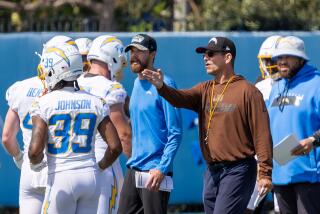In the Era of the Salary Cap, Chiefs Find Winning Formula
On the second Sunday of the season, the Kansas City Chiefs, playing at home, trailed the New York Giants 17-3 with seven minutes left. Converting three fourth-down plays, they tied the game and went on to win in overtime.
It was little noticed outside Missouri and New York but it set the tone for a 13-3 season by the Chiefs, the NFLâs best record in a year when Bert Bellâs adage about âon any given Sundayâ was literally true.
For in an era of legislated parity--the salary cap--it was less ability that separated the Chiefs from the 5-11 Giants and other teams at the bottom than luck, injuries, chemistry, heart and good management.
âWhen you have a finite amount of money to pay for players, everybody starts off even,â says Doug Allen, assistant executive director of the NFL players union. âSo the difference between good teams and bad ones is how well you mix and match your personnel.â
The Chiefs, picked to finish at the bottom of the AFC West because of Joe Montanaâs retirement, are the perfect example.
Their quarterback is Steve Bono, Montanaâs backup in both San Francisco and with the Chiefs. Heâs not a classic thrower like Dan Marino or an athlete like John Elway but heâs played in the same system since 1987.
Their top running back is Marcus Allen, not as quick at 35 as he was at 25 but heady and an example to every youngster in the locker room.
The secondary includes two guys cast off by the Jets, who finished 3-13 this year--cornerback James Hasty and strong safety Brian Washington. They were deemed negative influences in New York but theyâve been rocks in Kansas City.
âI canât tell you this is the most talented team Iâve ever had,â says Marty Schottenheimer, the Chiefsâ coach. âI can tell you that thereâs something special about it, something that transcends ability. As a unit, it knows how to dig down for whatever it needs.â
Schottenheimerâs coaching also has something to do with it--heâs now been in the playoffs in 10 of his 11 full seasons as a head coach.
The same holds in Pittsburgh, where Bill Cowher has made it in all four of his years, largely by molding his philosophy to his talent rather than vice versa.
After losing the AFC championship game at home last year to San Diego--a game the Steelers should have won--Pittsburgh re-tooled by necessity and design and finished 11-5 after a 3-4 start.
There was addition by subtraction--Barry Foster and his $2.5 million salary dispatched to Carolina and then to limbo. There also was subtraction by subtraction--defensive coordinator Dom Capers became the Panthersâ head coach and the two best cornerbacks, Rod Woodson and Deon Figures, were lost.
But Cowher adapted, opening up the offense to compensate for the defensive losses--seemingly against his own conservative leanings. It worked, thanks in large part to rookie Kordell Stewart, drafted in the second round as a quarterback and used as a wide receiver-option quarterback-running back.
The Chiefs arenât the only team that mixed and matched and thrived when they werenât supposed to. The Steelers arenât the only one that used coaching adjustments to thrive:
--Green Bay won its first AFC Central title in 23 years despite the loss of Sterling Sharpe to a career-ending injury and Bryce Paup to the Buffalo Bills, where he led the NFL with 17 1/2 sacks. But their absences allowed Robert Brooks, Mark Chmura and Wayne Simmons to stand out--Brooks, second fiddle to Sharpe, finished with 102 catches, 44 more than his previous best and Chmura, the tight end, caught 54, more than three times what he had totaled in his previous two seasons.
--Buffalo, an aging team coming off a 7-9 season that followed four straight AFC championships, bolstered its defense with Paup and some other free agents and won the AFC East. One secret: a front office headed first by Bill Polian and now by John Butler thatâs produced little-known draft gems from Andre Reed to Kurt Schulz to Darick Holmes.
--Philadelphia, which finished 1994 with seven straight losses, added 31 new players, challenged Dallas for a while in the NFC East and made the playoffs at 10-6, earning rookie Ray Rhodes coach of the year honors. This is a team that lost Reggie White, Clyde Simmons, Seth Joyner and Eric Allen and replaced them with Andy Harmon, William Fuller, Kurt Gouveia and Mark McMillian, paying big bucks only to Fuller.
--Expansion Carolina, with Polian directing things, won seven of its last 11 games, more than doubling the previous win output for expansion teams and coming within three points of becoming the first expansion team in any sport to finish at .500.
If those teams represent the way to rise above the masses in the NFL, the opposite can be seen in:
--Miami. Loaded with big names signed with $18 million in signing bonuses, the Dolphins barely made the playoffs at 9-7, the last seed in the AFC.
--Cleveland. One of the preseason choices to make the Super Bowl from the AFC, the Browns finished 5-11, going 1-8 after the announcement that the team would move to Baltimore next season. Andre Rison, whom owner Art Modell paid a $5 million signing bonus with borrowed money, was a bust.
--Oakland. The Raiders, transplanted back to their original home, started 8-2 and finished 8-8, largely because of the injury to quarterback Jeff Hostetler. In the salary cap era, few teams have room for a top-flight backup quarterback.
None of this means the playoffs wonât go as predicted at the start of the season--a Super Bowl victory by Dallas or San Francisco.
But thereâs hope.
Hurt by depth problems stemming from the cap, the Cowboys and 49ers lost nine games between them, more than twice as many as most predicted.
So as the playoffs start, teams like the Packers and Lions are given a chance to get through Dallas and San Francisco and on to the Super Bowl. And teams like Kansas City and Pittsburgh are given a shot, probably wishful thinking, at ending the NFCâs 11-year hold on the Vince Lombardi Trophy.
More to Read
Go beyond the scoreboard
Get the latest on L.A.'s teams in the daily Sports Report newsletter.
You may occasionally receive promotional content from the Los Angeles Times.










